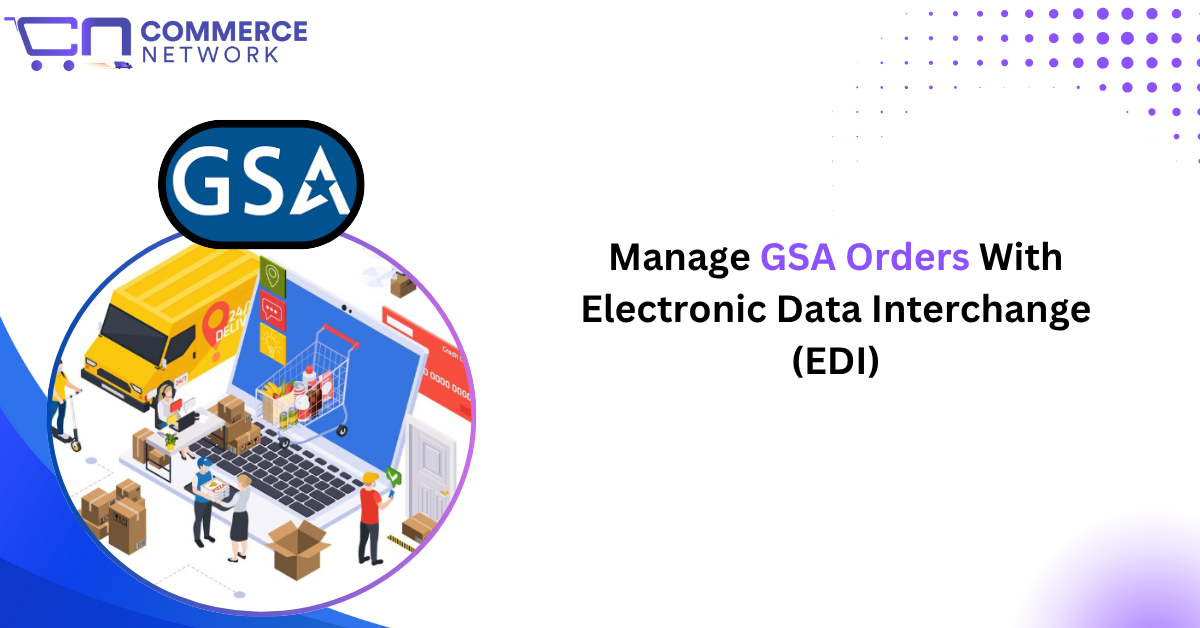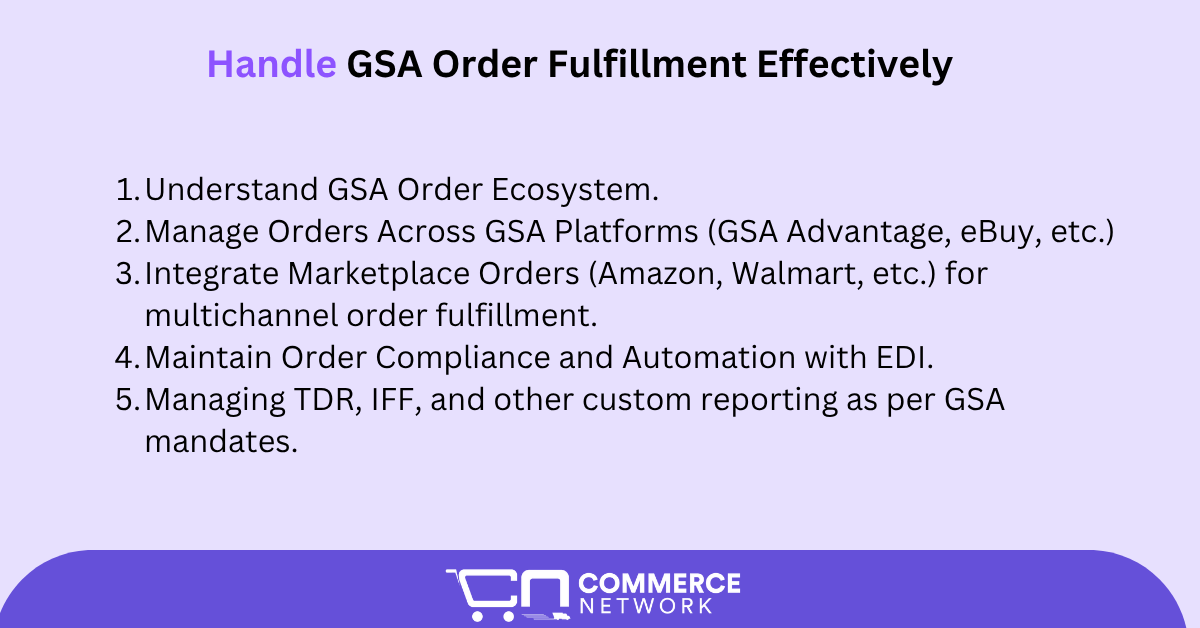By Bipin Dhungana | August 05, 2025

Managing orders from GSA and other marketplaces like Amazon and Walmart is not just about shipping products.
It involves navigating complex platforms, maintaining compliance, handling EDI (Electronic Data Interchange), managing reporting obligations, and keeping catalogs up to date. Businesses selling to the U.S. government through GSA Advantage, eBuy, Global Supply, and FedMall must ensure accuracy, timeliness, and automation in every step.
This guide breaks down how to effectively manage GSA orders across platforms, integrate marketplace orders, comply with federal requirements, automate EDI processes, and stay current with catalog and reporting requirements.
The U.S. General Services Administration (GSA) facilitates purchasing for federal buyers through multiple online procurement platforms. These platforms include:
a. GSA Advantage!
GSA Advantage is the primary online shopping portal for federal agencies. Vendors with a GSA Schedule can list their products, manage pricing, and receive purchase orders directly through the portal.
b. GSA eBuy
eBuy is used for more complex government acquisitions, often involving RFQs (Requests for Quotes) for large-volume or specialized purchases. Vendors submit quotes, and if selected, fulfill the order like any standard procurement.
c. GSA Global Supply
This is a requisition-based platform primarily used by military and federal buyers who require seamless and compliant procurement of mission-critical items. Unlike GSA Advantage, orders here are processed as traditional requisitions and must comply with specific fulfillment and packaging rules.
d. FedMall
While not managed by GSA but by the Defense Logistics Agency (DLA), FedMall is another key federal platform vendors must manage. It serves military and DoD users, and vendors must ensure separate catalog uploads, EDI setups, and compliance.
Each platform functions differently. A one-size-fits-all order management strategy won’t work. Here's how to streamline the process:
a. Centralized Order Management
Use centralized order management software or a custom-built dashboard to collect and process orders from all government platforms. This helps avoid duplication, order delays, or missed compliance steps.
b. GSA Advantage Order Handling
c. Handling eBuy Orders
d. Global Supply and FedMall
Orders follow strict packaging, barcode labeling, and ASN (Advanced Shipping Notice) requirements.
ASN and EDI documents like 855 (Order Acknowledgment), 856 (Shipping Notice), and 810 (Invoice) are often mandatory.
For FedMall, vendors must upload a separate catalog using the DLA’s catalog loader tool monthly.
Many federal buyers also purchase through commercial channels like Amazon Business and Walmart Marketplace. Managing these orders alongside GSA requires tight integration.
a. Consolidated Order Tracking
Use integrations that pull orders from Amazon, Walmart, and GSA into one dashboard.
Enable real-time inventory syncing to avoid overselling.
b. EDI Integration for Marketplaces
Some marketplaces, like Amazon Business, support EDI integration.
Set up automated workflows for PO receipt (EDI 850), shipping notice (EDI 856), and invoicing (EDI 810).
c. Price Parity and MAP Policies
Ensure that the pricing listed on Amazon or Walmart does not conflict with GSA’s price list.
GSA monitors for price discrepancies and may flag violations.
a. What is EDI and Why It Matters?
EDI (Electronic Data Interchange) is a standardized electronic format for exchanging purchase orders, invoices, shipping notices, and acknowledgments between vendors and government systems.
b. Key EDI Documents
These documents help automate order acceptance, shipment tracking, and payment processing.
c. Benefits of EDI Integration
d. Compliance Triggers
If vendors fail to respond to orders on time or submit incorrect EDI documents, they risk contract suspension or cancellation. Automation tools help maintain consistent compliance.
a. TDR (Transactional Data Reporting)
TDR is required for vendors under select GSA Schedule contracts. Vendors must report sales data monthly, including:
b. IFF (Industrial Funding Fee) Reporting
Vendors pay an IFF of 0.75% on all GSA sales. This must be reported and paid quarterly via the GSA’s FAS Sales Reporting Portal.
c. Automating Reports
Using integrated tools can automatically pull order data from your ERP or GSA system and generate reports. This saves time and ensures accuracy.
d. Penalties for Non-Compliance
Missed TDR submissions may result in audit flags.
Late IFF payments can lead to interest or contract termination.

Keeping your product catalog up to date is critical, not just for accuracy, but for compliance.
a. GSA Advantage Catalog Updates
Vendors must update product listings, pricing, and availability monthly (or sooner if there are changes).
GSA uses SIP (Schedule Input Program) or EDI for uploads.
Key Fields to Maintain:
b. FedMall Catalog Requirements
Uses a different format and platform from GSA Advantage.
Catalogs must include specific fields like:
Catalogs are submitted through DLA's Electronic Catalog Loader.
c. Best Practices for Catalog Management
Conduct monthly audits to validate SKU accuracy.
Ensure pricing consistency across GSA, FedMall, and other marketplaces.
Use automation tools to sync data from your ERP to your catalog.
Here’s how a government vendor might process an order across platforms:
Meanwhile, Amazon and Walmart orders are processed in parallel through the same ERP-integrated system, ensuring no manual work.
Here are some common tools used by contractors:
Commerce Network is built with deep expertise in government contracting and a strong understanding of the GSA order lifecycle. Our EDI-powered platform simplifies complex order fulfillment across all major government and commercial marketplaces, so you never have to worry about missing compliance steps or syncing data manually.
Here’s how we help you manage GSA orders seamlessly:
With Commerce Network, you get a full-service solution that takes the stress out of government order fulfillment, smart, fast, and compliant.
Ignoring platform differences: Treating GSA Advantage and FedMall the same can cause order failures.
Managing GSA orders is a blend of logistics, technology, compliance, and customer service. From handling multi-platform orders and syncing marketplaces to automating EDI and ensuring monthly catalog updates, every step counts.
The right tools and workflows not only reduce operational headaches but also help maintain a long, profitable relationship with the federal government and commercial buyers alike.
Improve Your B2B, B2G, and B2C Ecommerce?
Integrate EDI For Efficiency, Compliance, and Scalability?
Just Curious About EDI?
Give Us A Call
202-280-7060